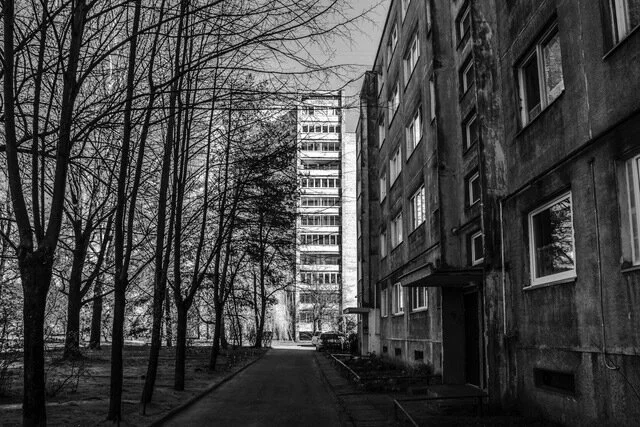How I rediscovered
post-Soviet
concrete nostalgia
By Ieva Žvinakytė
All photos / Ieva Žvinakytė
I grew up in what was a typical post-Soviet neighbourhood in Kaunas, Lithuania's second-largest city, akin to the scenery from the hit TV series Chernobyl. Rows and rows of identical five-story apartment blocks coloured in monotonous grey served as my playground, my jungle, my site of respite.
A newcomer could easily become dizzy seeing the horizon of endless concrete, but I knew every single building, corner and passageway of my childhood quarter by heart.
Behind drab cement block number one, my friends and I used to pick unripe apples from an arched tree. In between numbers two and three was an overgrown bush, our base, where we would come up with all sorts of childish plans. Number four had a basement covered in amateurish graffiti, where the boys would bring girls to scare them with ghost stories. Number five… I could go on and on, explaining what each of the identical buildings meant to us.
A typical post-Soviet neighbourhood, one of the thousands of uniform projects hastily constructed across the entire Soviet Union, wasn’t where the rich people lived in a newly independent Lithuania. But I felt rich. I didn’t know any better. My imagination went wild in the concrete paradise and I was fascinated by the people – each with their own story − cramped in small, underdeveloped living spaces.
Later, the world opened up to me. My family moved to a more prestigious neighbourhood and the monolith from my childhood became only a passing sight. A few years later, I moved abroad to study. For the first time I saw major European capitals. I met peers of other nationalities, who boasted of their private education and rich life experiences. I started to be ashamed of my post-Soviet origins and the concrete apartment blocks became symbols of destitution in my eyes.
For the past year, I’ve been studying and living in Paris. The city’s beauty contrasted so drastically with my hometown that I thought to myself: I could never again imagine living surrounded by such architectural abruptness.
Yet when the coronavirus crisis hit, I had no choice but to come back to my home country, where I could be closer to my family. I felt dragged out of my dream and brought back to reality – a reality I didn’t want to be in.
I moved in with a friend, who lives in one of the post-Soviet neighbourhoods monopolised by those very concrete square shapes I knew so well. The sense of backwardness interchanging with sadness filled me all over again.
But as the days passed and I spent more time back in what looked exactly like my childhood neighbourhood, I realised how wrong and ignorant I’d been about such places recently. As I strolled tirelessly among the concrete labyrinth, I saw joyful children playing there just as I did with my friends back in the old days. I saw elderly people on benches underneath the birch trees, enjoying the sunset behind one of the grey apartment blocks. I saw how the sun rays turned the concrete walls into a golden colour. I saw a life just as rich as the one offered by the fanciest of Parisian neighbourhoods – and even more authentic.
I realised how grateful I am to have grown up in a place where the walls were shaped by history. I‘m grateful for the circumstances that opened my eyes to what I now call post-Soviet concrete nostalgia.



